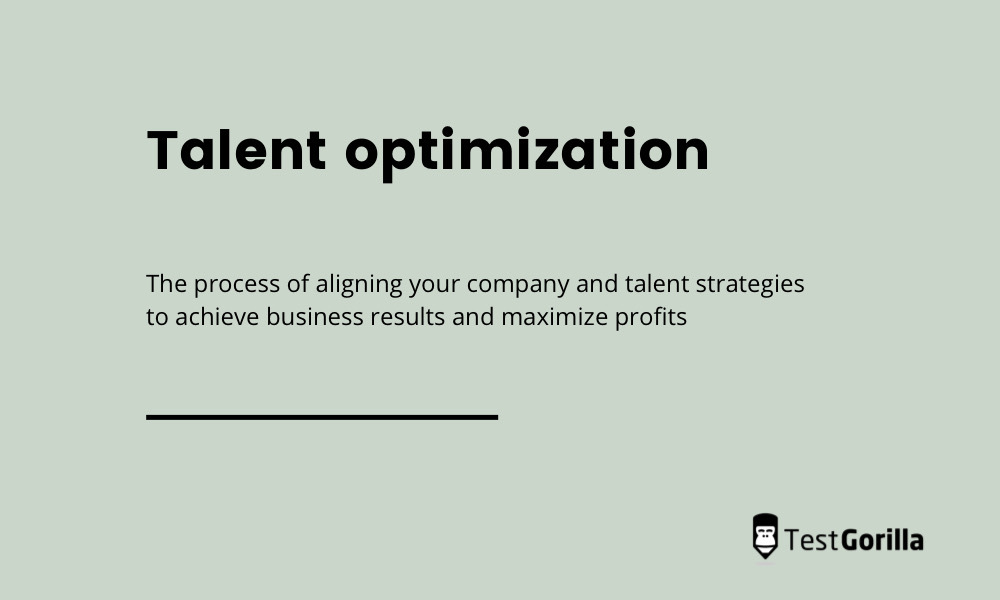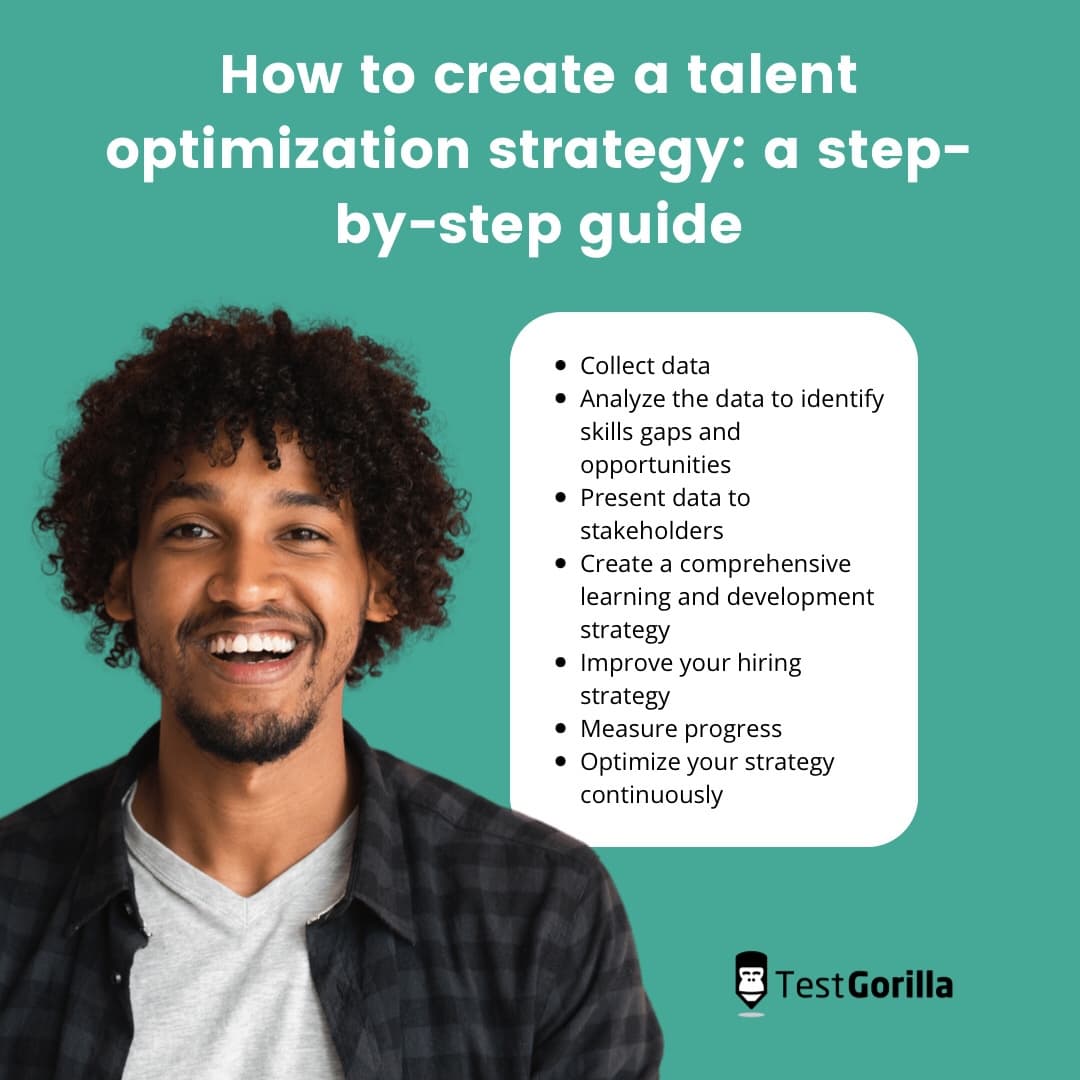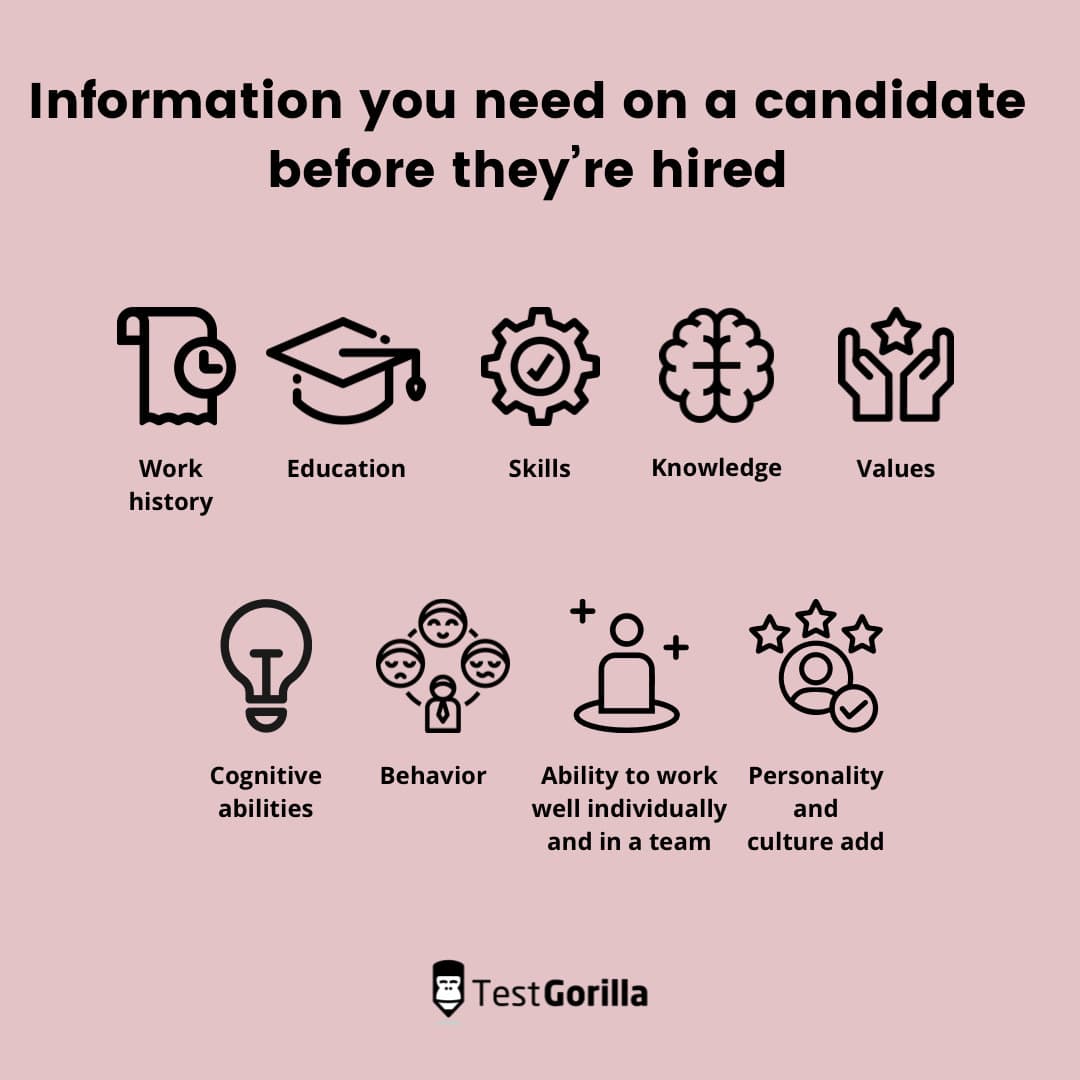To achieve your business goals and remain competitive, you need a talent optimization strategy that aligns with your business strategy. People are the driving force behind productivity and increased profits, so investing in your teams is what will bring you success in the long term.
In its State of the Workplace Report for 2021-2022, SHRM states that 84% of organizations reported labor shortages in 2021. During the pandemic, many US firms saw people resigning from their jobs due to health concerns. This “Great Resignation” left a vacuum of unfilled positions that will need to be occupied by qualified employees in 2022 and beyond.
The report also states that organizations’ top priority for 2022 is to focus efforts on talent recruitment and retention. This is why it is imperative that businesses put a talent optimization strategy into practice.
Talent optimization is the process of aligning your business and talent strategies. This means that to reach business goals, you first need to optimize your employees’ performance and ensure they have a positive experience at work. As a result, you will see improved retention rates, increased productivity, and ultimately greater sales and profits.
With the above in mind, your job as a hiring manager is not only to source the right people for the job. You also need to provide a work environment where all employees can thrive and grow, whether they are new hires or seasoned workers.
This means that you need to have a talent optimization strategy in place that enables everyone in the company to feel heard and appreciated, creating a workplace that people love and want to come back to every day.
This article will describe talent optimization and its benefits, how to create a talent optimization strategy, and what challenges you can expect along the way.
Table of contents
What is talent optimization?
As mentioned, talent optimization is the process of aligning your company and talent strategies to achieve business results and maximize profits. To better understand talent optimization, however, we first need to define what a business strategy and a talent strategy are.
What is a business strategy?
The International Institute for Management Development (IMD) defines a business strategy as a “clear set of plans, actions and goals that outlines how a business will compete in a particular market, or markets, with a product or number of products or services.”
Essentially, it is an actionable plan that steers your company one way or another in an attempt to outplay the competition and come out on top.
A business strategy is a vital element of any company that seeks growth. To have a successful business strategy, you need to involve your management (who will implement the strategy and lead its execution), plenty of resources (financial, labor, and technical), a good marketing plan, and a supportive company culture in which all of the above can flourish.
Without a business strategy, your company will struggle to rise above its competition.
However, a business strategy isn’t all you need to make your organization successful – you also need to implement an effective talent strategy.
What is a talent strategy?
Your talent strategy should aim to source the right people for the right jobs while offering them adequate remuneration. Having a talent strategy in place can give you that extra edge over the competition because it focuses on your employees.
In short, a talent strategy aids your organization by:
Identifying labor shortages within your company
Finding new hires to fill open positions
Engaging employees and bringing them up to speed with organizational processes
Retaining new and old employees alike
In essence, a good talent strategy will provide you with a workforce that meets your company’s needs and goals productively and efficiently.
Since people are your greatest asset, you cannot use your business strategy without a talent strategy. Even if you have a great business strategy planned out, if you have no one to implement it, or you have the wrong people implementing it, chances are your business will not succeed.
With good business and talent strategies at hand, any company can thrive. Aligning these two strategies, however, will optimize these processes and create a talent optimization program that will greatly enhance your business.
Aligning business and talent strategies to create talent optimization
Now that we have an idea of what business and talent strategies mean, we can understand the essence of talent optimization.
Talent optimization takes talent strategy a step further by investing in and developing employees’ skills and assets while following the guiding principles of the business strategy.
You can use talent optimization to focus on improving employee experiences at work, which will benefit not only your staff but also your business in the short and long term.
However, anything you do to improve the experiences of employees must align with your business strategy, which is the reference point your organization should use to make decisions and take actions.
Therefore, if you decide to perform any kind of activities to enhance your employees’ skills and knowledge, those activities have to reinforce your business strategy.
For this to happen, your employees need to be truly immersed in the organization’s culture. If someone doesn’t understand what your company does or why it does it, they won’t collaborate as easily as someone who has an emotional bond with the organization.
When business strategies don’t produce the desired results, the most likely cause is that the people tasked with producing those results are not as efficient as they could be.
Most of the time, this is because they are either not a good culture add for the company or are not immersed in its culture. Alternatively, they may not possess the right skills or knowledge to do their jobs effectively.
This is where talent optimization comes into play. It enhances your employees’ abilities through your company’s culture to bring about the desired effects.
There are many benefits to talent optimization, which we will discuss in the next section.
What are the benefits of talent optimization?
Talent optimization can have numerous benefits for your business when it is implemented correctly.
As mentioned, companies are made up of people, and creating a plan to attract, onboard, train, motivate, engage, and retain these people is what will drive your organization to success.
This can be referred to as strategic people planning – the process of identifying and analyzing your business needs and how to meet them through adequate staffing strategies.
As an HR manager, you need to ask yourself, “What is the company trying to accomplish, and how can we meet those requirements through our employees?” This is where you go back to the business strategy and analyze the goals the organization wants to achieve.
Once you have a better understanding of these goals, you can start creating a talent optimization program that supports employees from the moment they are hired and gives them the necessary resources to enhance their performance. Ultimately, this will drive the results outlined in the business strategy.
When implementing a talent optimization strategy, you can expect to achieve the following.
1. Attract talent
The biggest challenge for hiring managers and recruiters alike is finding the right talent for the right job.
Companies invest a great deal of time and resources into finding and attracting top talent, but without a good recruitment strategy in place, the process of sourcing the right people will remain elusive.
Indeed, if an employee is ill-suited for a position, their productivity will be low, your company will struggle to achieve results, and you will have spent resources on someone who is ultimately not the right person for the job.
This is where talent optimization comes into play.
As a hiring manager, you need to find out what expertise your company lacks and determine the criteria for each open position. Then, you need to determine where you’re going to source your talent.
There are multiple talent pools you can use for talent sourcing:
Internal employees
Job boards
Social media
The idea here is to gain a comprehensive view of the talent you can potentially use to fill a position in the future rather than to try and immediately fill an open role.
When sourcing talent, you need to think about who would be optimal for a given position. Maybe someone from within your current team is the perfect fit, or perhaps it would be better to bring in an external contractor who can offer a fresh perspective.
Ideally, you should use pre-employment tests to identify top talent. These tests assess a job candidate’s soft and hard skills and expertise in specific areas. You can even measure whether they will be a good cultural fit, which is vital for talent optimization, as mentioned above.
You must think three steps ahead when it comes to your company’s workforce. This means constantly evaluating, analyzing, and sourcing talent to attain the desired results outlined in your business strategy.
This is why using talent optimization to attract talent is key for every business endeavor. The benefits you can expect from implementing such a strategy are well worth the effort.
2. Improve employee engagement
Talent optimization will also aid you in engaging your employees, especially new ones.
Once you have located and attracted new talent, you need to engage them from the start. Most companies have a formal onboarding program but often neglect important aspects of the onboarding process, making it feel cheap and unengaging.
Onboarding programs enable companies to meet goals and increase retention rates while helping employees to be more productive and hit their performance goals.
This is why it is imperative to have a good onboarding process to engage your new hires from the start.
Engagement is crucial for your business because employees make decisions every day that affect their colleagues and your company, either positively or negatively.
According to a report made by Gallup, companies in the top quartile in terms of employee engagement have 81% lower absenteeism, 64% fewer work-related accidents, 18% higher productivity, and 23% more profitability than companies in the bottom quartile.
These numbers show the advantages held by top-tier companies that are engaging their workforce compared with low-tier ones that are failing to do so.
According to the same report, the main drivers of employee engagement are:
Purpose
Development
A caring manager
Ongoing conversations
A focus on strengths
Even though a high paycheck will make employees happier, it is not enough to make them more engaged. On the other hand, you can use talent optimization to engage your employees by giving them a purpose and meaning at work, encouraging them to develop, talking to them, and focusing and expanding on their strengths.
Gallup also states that most engagement programs don’t work nowadays because they are considered an HR issue. It is precisely here where your talent optimization plan will prove useful.
As an HR leader in your company, you’re not only optimizing new hires but everyone within the company, including seasoned workers and management.
Once everyone starts doing their bit to create a reassuring, engaging, and motivating work environment, employees will feel content and have a sense of belonging, increasing their productivity.
You can improve employee engagement by:
Talking to employees
Seeing if all their needs are being met
Checking in with them regularly
Ensuring they have the necessary tools to do their job
Giving them resources to grow
Providing them with performance feedback
Recognizing their successes
Once you start engaging your employees more through your talent optimization strategy, you will see positive business results immediately.
3. Recognize the strengths of each employee
Talent optimization will aid you in identifying each of your employees’ strengths, and you can use that information to develop and build upon these assets.
If you use pre-employment tests before hiring new personnel, you will already have an idea of what skills new hires lack and where their strengths lie.
Your talent optimization strategy needs to focus on the individual and assess how they are performing and whether or not they are growing and meeting their goals.
It is important to point out that companies now attract and hire employees from all walks of life, and you could end up having a team made up of very diverse members, each with their own individual needs, wants, and strengths.
Therefore, as an HR leader, you need to be able to organize specific training programs and traineeships that cater to each employee. Otherwise, you run the risk of failing to optimize different employees by placing them all in the same one-size-fits-all programs.
You can discover and develop each employee’s strengths by using:
360-degree feedback surveys
Coaching
Mentorships
Individual performance reports
When organizing these activities, it is critical to involve the management of your entire company so that each manager can focus on their team. Since they work closely with each employee on their team, managers have the best view of how each individual is performing. Thus, they can give employees specific training tools and advice on how to grow.
Individual performance optimization will empower and motivate employees to work on their own to further develop their skills, giving them a sense of ownership and confidence in their careers.
4. Close skills gaps
Skill gaps within your organization can negatively affect your overall business results since your team is not optimized to achieve business goals effectively.
By using talent optimization in the form of a skills gaps analysis, you can see what skills your employees are lacking that are necessary to perform specific job roles and tasks.
Since you will have already determined what strengths your employees possess, you can easily put the right people in the right jobs. You can also begin retraining programs and mentorships to eliminate any of your employees’ lingering skill gaps.
Overall, you need to assess employees’ skills to understand what your company needs. Talent optimization enables you to do exactly that.
5. Retain top talent
Your talent optimization program should aim to retain your top talent at any price. This can be done by providing them opportunities to develop, learn new skills, and nurture positive connections with their peers.
Often, companies try to retain only their top performers without paying much attention to the rest of their workforce. However, they can miss out on promising employees who have the potential to become top performers but first need to be trained and developed.
Therefore, organizations need to think of all of their employees as potential super-workers if given the tools to develop. This is also a way to reduce employee turnover on a large scale.
Talent optimization will help you to retain employees by:
Encouraging them
Offering them the right incentives
Not overworking them
Training and upskilling them
Allowing them the flexibility to manage their work/life balance
6. Be more agile and adaptable
Another benefit of talent optimization is that it enables your company to be more agile and adaptable to changes.
Change is inevitable in businesses. There are so many factors you cannot foresee, like market crashes, cataclysms, rising inflation, pandemics, and war. All of these elements can bring an organization to its knees if it is not flexible enough to withstand difficulties.
By using talent optimization, you will have a motivated, high-performing, and driven workforce that can withstand any calamity. Your business will be able to stay afloat and continue its work, making it much more resistant to sudden changes.
7. Create the right succession planning process
Talent optimization will also aid you in devising your succession planning process.
No matter how good an employee is at their job, they will eventually need to retire and have someone else take on their role. This is why having a good succession plan is a must, and talent optimization is a key factor in keeping important roles occupied at all times.
Succession planning is the process of identifying important roles in your company and which employees have the necessary skills and knowledge to fill those roles once their occupants retire or move on to another job.
By having a good talent optimization plan in place, you will never lack employees with the right experience and expertise. Many workers will likely stay with your company for a long time since their needs are being met, so you will have a wide array of workers to choose from when you need to fill a position.
Thus, your company will become even more resilient to change since important roles will never be left vacant and there will always be someone to make strategic decisions when necessary.
How to create a talent optimization strategy: a step-by-step guide
1. Collect data
When creating your talent optimization strategy, your first task is to collect data.
Usually, companies begin by asking job applicants for their resumes and work history. But this is an insufficient approach if you want to create a comprehensive talent optimization strategy.
You need to be gathering data starting from when a candidate sends an application for a position to the day they begin working at your organization and throughout their tenure.
Beginning from before someone is hired, you need to have information on their:
Work history
Education
Knowledge
Skills
Behavior
Cognitive abilities
Values
Ability to work well individually and in a team
Personality and culture add
The candidate provides some of this information themselves, and some you will gather when they begin working with you.
However, to gain deeper insights into their cognitive abilities, personality, culture add, and skills, you need to run them through pre-employment skills testing.
This way, you will avoid bias in the hiring process and know what to expect when hiring a candidate. In addition, pre-employment skills testing enables you to go beyond a well-written resume letter and see if someone is top talent in reality and not just on paper.
Even after you hire your chosen candidate, you should continue collecting data. Gather information on individual and team performance, and keep tabs on whether everyone is achieving their goals, upgrading their skills, and expanding their knowledge.
Some of the datasets you want to continuously gather information on include:
Employee engagement, or whether or not employees enjoy their work and how that affects them, their teams, and the organization as a whole.
Job performance, or how well employees are achieving their goals and showing positive results. Use your business strategy as the focal point for measuring job performance.
Organizational culture, or how well employees match with the culture of your organization and how that affects their values and norms. As mentioned, culture is a vital aspect of talent optimization, and if it’s not embodied by everyone, the risks of your strategy not working are greater.
These are a few of many datasets you can monitor, but depending on your organization and industry, you will likely want to include more.
To obtain this information, use performance management gathering tools, like job satisfaction surveys, 360-degree feedback reviews, one-on-one interviews, coaching sessions, and other methods. The idea is to get as much information as possible so you can analyze it and use it properly.
With this information readily available, you can begin creating your talent optimization strategy.
2. Analyze the data to identify skills gaps and opportunities
Once you accumulate enough data for each individual and team in your organization, you can begin analyzing it to identify what skills gaps employees have and what opportunities are being missed due to these skills gaps.
Analyzing your organization in such a way will most likely uncover issues that aren’t all that obvious at first glance. However, this proactive method will enable you to take quick and effective measures and remedy any issues.
When analyzing the data, however, you may find an array of problems that require your attention. If you try to fix them all at once, you will probably fail to solve any of them. Thus, you will have to determine the magnitude of each problem and choose which ones to tackle first.
To do this, analyze how often a problem occurs, its ramifications, and whether it is related to individual employees or whole teams.
Understanding the severity of different issues will enable you to decide which ones you need to handle immediately and which you can leave for later on.
3. Present data to stakeholders
Once you have analyzed the data and pinpointed what problems your organization has, you need to present the data to your stakeholders.
Your company’s leadership needs to be on board with the process for talent optimization to work. Therefore, they need to understand all of the underlying issues and how to address them.
Your management teams will be the ones to administer the corrective actions you prescribe and give you constant feedback on how everyone is progressing. That’s why it’s important to keep them in the loop and stay on their good side if you want your talent optimization strategy to succeed.
Management can also give you specific insights into how their teams and individual employees work that you might not be able to gain on your own. This will enable you to create an even more encompassing strategy, so having everyone on board with the talent optimization process is a must.
4. Create a comprehensive learning and development strategy
Once everyone is on board with talent optimization, you have the necessary data, and you have identified what needs to be done, you can move on to prescribing improvement actions.
You need to determine the best course of action and how you will achieve your intended results. A good way to do this is to have a comprehensive learning and development (L&D) scheme in place.
Technologies are constantly evolving, so the skills someone possesses today could become obsolete in several years. Therefore, you need to use a good L&D scheme that improves employees’ knowledge, skills, and attitudes.
By this point, you will know what skills are missing in your organization. Using your business strategy, which outlines your company’s goals, you can prescribe upskilling and training sessions to improve your employees’ skills and knowledge.
If necessary, you can even hire an external firm to provide coaching sessions and unbiased feedback.
Whatever course of action you decide on, this is where your talent optimization strategy shows its potential. These methods will improve not only your work metrics but also your employees’ satisfaction and motivation. Actively trying to help and develop your staff will keep your retention rates high.
5. Improve your hiring strategy
As your talent optimization strategy takes root within your organization, you can use the information you gathered to improve and upgrade your hiring strategy.
Since you now know what skills and opportunities your company needs, you can use the data to focus on hiring people with the right track record and skills. This way, you won’t need to create specific training sessions for these people and will employ only those who can actually meet your standards.
Nevertheless, however skillful your hires might be, at some point, they will need to receive additional training to remain competitive and useful within your organization. Your business will always be facing new changes, so remember to continuously upgrade your methods and improvement prescriptions.
6. Measure progress
You will need to constantly evaluate the results of your talent optimization strategy.
Monitor how individual employees and teams are progressing after you have given them extra training. You can measure employees’ success by identifying goals and seeing whether or not they are achieving them.
If they are, then your talent optimization strategy is working. If they aren’t, you need to make modifications to ensure you get the right results.
7. Optimize your strategy continuously
To stay ahead of the competition, measure progress at regular intervals (every six months to a year) to make sure you’re moving in the right direction.
Bear in mind that competing firms will probably also be running a talent optimization scheme, so you want to constantly improve and tweak your methods to get the best results.
With time, you will understand what works and what doesn’t. As you remove less successful methods and add more effective ones, you will optimize your talent optimization strategy, making the process more efficient and productive.
The challenges of talent optimization
As we have seen, creating a talent optimization strategy for your company has immense benefits.
Combining all of the aspects we have described can supercharge your organization, enabling you to constantly reach your business goals, get the right results day in and day out, and increase your company’s readiness to overcome challenges and seize opportunities.
However, talent optimization can be challenging and requires great discipline to achieve. Here are some of the hurdles you might face during the process.
1. It can be a lengthy process
To have a successful talent optimization strategy, you will need to invest time and resources and have the patience to wait for results.
It will take time to implement the strategy, integrate it within all departments, and get everyone on board.
As an HR leader, you will need to approach teams and individuals to understand what their needs are, what skills they need to develop, and the best ways to aid them.
Keep in mind that the process will be easier with some employees than others, so it’s necessary to be patient and understanding. Otherwise, you may feel disheartened if results don’t come straight away.
2. You need to make sure you have the right data
Without the proper data, you will not succeed in implementing your talent optimization strategy.
The process requires you to collect information about employees’ performance and results at all times within your organization.
Rather than just trying to wing it, you can use this data to make objective decisions on what needs to be done. It’s best to use a systematic, objective approach to collecting data since you need to be constantly enhancing your datasets.
Without the insights you gain from data collection, your talent optimization strategy will most likely fail because it will not be based on objective information.
3. Leadership support is essential
A critical aspect of the talent optimization process is receiving the support of your leadership.
If you don’t get everyone in managing positions on board with the talent optimization strategy, the whole process will be ineffective. You need to speak with management constantly about what teams and individual employees need so that they can make the right decisions.
After all, managers have more control and understanding of their own teams and can provide them with the necessary resources to achieve the talent optimization strategy’s goals.
They can also give you feedback on how individual employees are progressing and whether or not they are accomplishing their designated goals. You can then tweak the process as needed to get the most out of your talent optimization strategy and drive your business to success.
4. Improvement is gradual and results aren’t always instantly visible
Finally, don’t expect immediate results. Improvements in talent optimization will be gradual at first.
It’s important not to give up if you don’t see benefits right away. Instead, constantly apply different changes to your talent optimization approach based on the data you collect, and eventually, the results will come.
As long as you stick to the plan, your talent optimization strategy will be the driving force behind your organization’s progress. Sooner or later, it will increase sales and improve employee performance at every level, from top management to first-line workers.
Use talent optimization to future-proof your organization and empower your employees
If you want to succeed in today’s business world, you need to be using a talent optimization strategy.
It will help your business to grow, redefine itself, refine its processes, and beat the competition. However, you need an efficient and highly productive workforce that will drive change.
Optimizing your teams will enable you to accomplish your company’s strategic goals and increase revenues over time. Your teams are the backbone of your organization’s success, so enhancing them will also improve your business outcomes.
With TestGorilla, you’ll find skills testing for talent optimization to be simpler, faster, and much more effective. Get started for free today.
Related posts
Hire the best candidates with TestGorilla
Create pre-employment assessments in minutes to screen candidates, save time, and hire the best talent.
Latest posts
The best advice in pre-employment testing, in your inbox.
No spam. Unsubscribe at any time.

Hire the best. No bias. No stress.
Our screening tests identify the best candidates and make your hiring decisions faster, easier, and bias-free.
Free resources
This checklist covers key features you should look for when choosing a skills testing platform
This resource will help you develop an onboarding checklist for new hires.
How to assess your candidates' attention to detail.
Learn how to get human resources certified through HRCI or SHRM.
Learn how you can improve the level of talent at your company.
Learn how CapitalT reduced hiring bias with online skills assessments.
Learn how to make the resume process more efficient and more effective.
Improve your hiring strategy with these 7 critical recruitment metrics.
Learn how Sukhi decreased time spent reviewing resumes by 83%!
Hire more efficiently with these hacks that 99% of recruiters aren't using.
Make a business case for diversity and inclusion initiatives with this data.

























